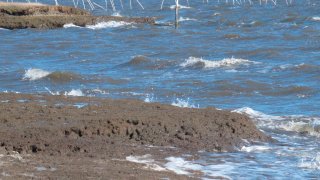
New Jersey will study its coastal marshes, estuaries and back bays to develop a list of projects to help protect shore communities, restore damaged ecosystems, and prevent the release of planet-warming carbon into the atmosphere.
The state Department of Environmental Protection is providing $150,000 for the effort, called the Coastal Ecological Restoration and Adaptation Plan, that also will include teams from Rutgers University.
The goal is to develop a list of projects the state can fund and execute in the coming years to protect communities from storms and rising seas, and also to reduce the state's contribution to climate change.
“New Jersey stands to endure, unfortunately, a great deal of harm from climate change,” said Shawn LaTourette, the DEP's acting commissioner. “We need to be ready for that. But the work of planning is hard, and long-lasting. This plan is at the beginning of that effort.”
Get Tri-state area news and weather forecasts to your inbox. Sign up for NBC New York newsletters.
Starting in mid-April, teams will fan out across the state's 127-mile shoreline looking for projects that can accomplish more than one beneficial goal at once. For instance, restoring coastal marshes could help protect an area from storm damage or flooding, while at the same time preventing those marshes from releasing large amounts of carbon dioxide that they have stored into the atmosphere if the marshes degrade or die.
The study will also aim to pair “green” projects like habitat restoration with harder-engineered projects like storm barriers where warranted, said David Rosenblatt, assistant DEP commissioner and New Jersey's chief resilience officer.
Situations the survey aims to tackle include coastal ecosystem degradation and habitat loss; shoreline erosion; damage from storms and rising sea levels; so-called “sunny-day” or “nuisance” flooding; water quality degradation, and areas at risk of losing trapped carbon.
Local
The survey is part of a larger overall climate resiliency plan that the DEP plans to release in the next few weeks.
The goal of that effort is “to reduce and respond to climate change, to reduce emissions to such a significant degree that we have a chance to avoid some of the worst impacts of climate change," LaTourette said. “That's a gargantuan undertaking.”
The effort will examine whether coastal marshes deemed to be threatened can be relocated or recreated further inland where they'll be at lower risk of inundation from rising seas or storm surges.
Some similar projects are already on the drawing board or under way, including one to stabilize Mordecai Island, a small spit of land off the coast of Beach Haven near Long Beach Island. The DEP and the U.S. Army Corps of Engineers are studying ways to slow or halt erosion of the island, which is losing 3 to 6 feet (1 to 2 meters) of its western edge each year.
Over the past 100 years, half the island has been lost to erosion. It is an important breeding and nesting area for many birds.
And in Ocean City, Shooting Island, a spot of land in the bay that has suffered serious erosion, is undergoing a shoreline restoration program. It is using some of the same techniques envisioned for other projects statewide, including the installation of underwater rock sills to break up and absorb some of the energy of incoming waves; the establishment of offshore oyster reefs in cement cages to serve the same purpose while improving water quality, and the use of dredging spoils to replace land mass lost to erosion.
Public education and input will be part of the effort, and local support is considered crucial to the projects getting done.
“The locals are often the ones pushing for these projects,” Rosenblatt said.
Richard Lathrop, a Rutgers professor directing the effort, said it aims to produce a publicly available web-based “visualization and decision support tool” including proposed projects and ones already completed.
“We can't just sit back and wait,” said Rosenblatt. “We have the science; we know what is going to happen. It's time to act on it.”



